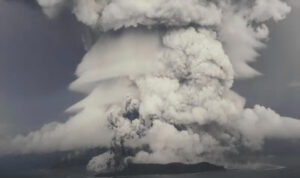AUGUST 4, 2022

On January 15th, 2022, Tonga’s Hunga Tonga-Hunga Ha’apai volcano erupted, spewing tons of gas and ash into the atmosphere. According to a Wednesday report by National Public Radio, the blast contained enough water vapor – notorious for its heat-trapping abilities – to temporarily raise Earth’s temperature.
“The massive amount of water vapor is roughly 10% of the normal amount of vapor found in the stratosphere, equaling more than 58,000 Olympic-size swimming pools,” NPR wrote.
The chemicals “came from a volcano that’s more than 12 miles wide, with a caldera sitting roughly 500 feet below sea level. One day earlier, Tongan officials reported the volcano was in a continuous eruption, sending a 3-mile-wide plume of steam and ash into the sky. Then the big blast came, sending ash, gases and vapor as high as 35 miles — a record in the satellite era — into the atmosphere,” per NPR.
In a July paper published in Geophysical Research Letters, scientists discovered that Hunga Tonga-Hunga Ha’apai “may be the first volcanic eruption observed to impact climate not through surface cooling caused by volcanic sulfate aerosols, but rather through surface warming.”
Water vapor lingers in the air, which contributes to its ability to retain heat.
“It normally takes around 2-3 years for sulfate aerosols from volcanoes to fall out of the stratosphere. But the water from the Jan. 15 eruption could take 5-10 years to fully dissipate,” NPR explained.
“We’ve never seen anything like it,” said atmospheric scientist Luis Millán, who led the research team and works at the National Aeronautics and Space Administration’s Jet Propulsion Laboratory in Pasadena, California. The volume of water was “unprecedented,” Millán noted. “Three natural pathways for direct injection of H2O into the stratosphere exist: overshooting convection, pyrocumulonimbus (pyroCb) storms, and volcanic eruptions.”
Millán added that “the HT-HH eruption injected at least 146 ± 5 Tg of H2O into the stratosphere, not only surpassing the magnitudes of all other injections in the MLS record, but also eclipsing a theoretical estimate of 37.5 Tg from Pinatubo.”
Tg stands for teragram – or a trillion grams. That, Millán concluded in his paper, is “an exceptional amount of H2O.”

































































































